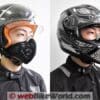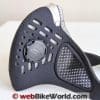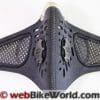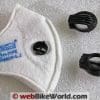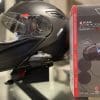Riders who commute regularly in urban environments with lots of congestion and/or air pollution have to take extra steps to protect their long-term health.
UK company Respro makes masks to help you breathe a little easier
Motorcycles are superior commuting devices in almost every respect.
They’re light, efficient and fun.
As a biker, once you get over the weather and danger issues (or if you do) then there’s not much else to think about.
But the world is getting more crowded. Cities especially see more airborne pollution from all types of vehicles and many different industries too.
While all the car drivers are stuck in their death boxes, bikers are out there having all the fun — except when it comes to being exposed to airborne pollution.
Do You Need a Sportsta?
According to the U.S. Environmental Protection Agency (EPA), the major constituents of airborne pollutants are particulate matter, which are “a mixture of microscopic solids and liquid droplet suspended in the air”.
These tiny particles can have a number of origins, including acids (of nitrate and sulfur), organic chemicals (a broad term for any chemicals with carbon), metals, soil, dust and allergens (pollen, fungi, mold spores). It all sounds like a nasty cocktail and it is, since all these substances can have an effect on your personal health.
The EPA says that particles less than 10 micrometers in diameter (known as PM 10s) are the most dangerous, since they can be inhaled easily and penetrate deep into the lungs. Things like dust and ash are around this size.
One micrometer is equal to 0.001 millimeter, so even at 10 micrometers, these are very, very small particles. The Pima County, Arizona (U.S.A.) Department of Environmental Quality has a very good web page with a simple description of particulate matter and health effects.
Particles smaller than 2.5 micrometers (PM 2.5) in diameter are even more dangerous, and can even get into where gas exchange (blood and oxygen/carbon dioxide) occurs between the lung and bloodstream. PM 2.5s include soot, smog and fine dust.
Short term effects include eye irritation, bronchitis, respiratory infections, while long term effects include reduced lung function, chronic lung/heart diseases and respiratory diseases such as asthma.
According to the British medical publication The Lancet, exhaust pollution is the singular biggest, and most preventable, cause of heart attacks to the general public — 7.5 percent of the total.
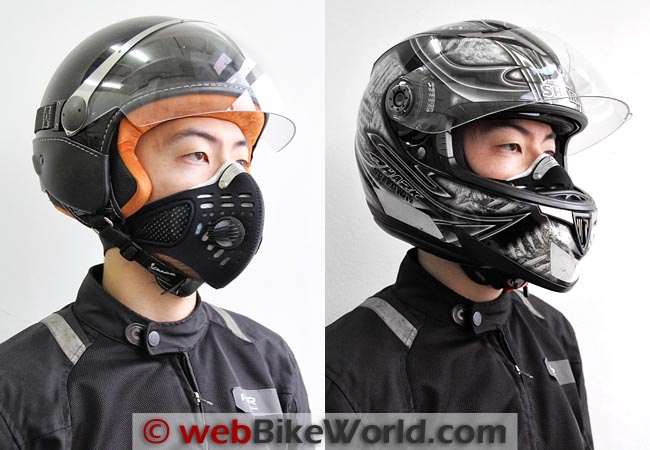
The Respro Sportsta Mask
British safety equipment company Respro makes products to help you avoid most of this nasty stuff. Respro makes a wide range of respirator products for industry (hence the name, we guess) but also some interesting motorcycle-related products also, like the high-viz “Hump” backpack cover, the Respro Foggy anti-fog mask and raincoats for leather racing suits.
But it’s the filtration masks we’re most interested in here, which is why we purchased a Respro Sportsa mask and an additional Respro “Techno” filter to test for use during commutes.
Respro lists three different masks as being most applicable for bikers: the City, the Sportsta and the Techno (there is a Techno mask and and a Techno filter, which is a bit confusing). Each mask has a replaceable filter unit inside; the filters are standardized so any filter can be used in any mask type.
In brief, the Respro City mask is for cycling, walking or urban commuting, while the Sportsta is designed with rural use in mind, including sports such as adventure-touring, off-road riding, motocross, mountain biking, horseback riding, snowboarding and others.
The Respro City mask has less ventilation and is equipped with a “Techno” filter, which has more filtering properties. The Techno mask combines characteristics of both the City and Sportsta masks, taking the Sportsta’s breathability and combining it with the extra filtering capacity (activated charcoal layer) of the City.
According to Respro, the Sportsta mask is equipped with a filter that has “sub-micron” capability, which (supposedly) means that it can filter out particulates less than 1.0 micrometer in size, up to a quoted minimum of 0.3 microns. This filter is of the HEPA type, or “High-Efficiency Particulate Air” and made of fibreglass fibres, which trap particulate matter and/or pollutants.
Compared to the City mask, the Respro Sportsta also has higher ventilation rates, which helps if it’s used during rigorous activities. The two breathing valves (one on each side) on the Sportsta mask are of the high-flow “Powa” type.
The Sportsta mask will filter out most of the bad stuff in air pollution, with the exception of gaseous pollutants, such as sulphur dioxide and nitric oxide. Those are atom-sized gases, so you can’t really filter them out with a particulate filter.
Respro says the Sportsta mask meets the requirements for filtering as set down by the ECE directive number EN 149FFP1(S) for solid aerosol products and is “usable in all outdoor sports pursuits requiring respiratory protection”.
The Techno filter in the Respro City and Techno masks (again, it’s a bit confusing) has the same sub-micron properties as the Sportsta, but it also includes an activated charcoal cloth layer and valves with lower flow.
The charcoal cloth layer is what makes it more effective, and can remove benzene, pyrene, oxides of sulphur and nitrogen (significant components of exhaust fumes) lead oxide and soot, as well as volatile organic compounds.
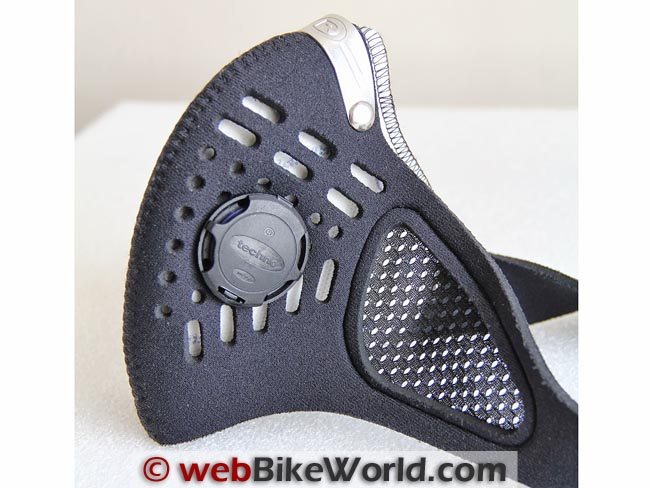
Riding With the Respro Sportsta Mask
Respro offers most of its masks in two sizes, Medium and Large, with Large able to fit most male riders and Medium designed for women or those with smaller faces. We evaluated the Large size here.
The Sportsta mask is simple to wear — you just put it on and fasten the Velcro hook-and-loop pieces behind your neck. The pieces are quite wide, so there’s a bit of scope for tweaking the length. One happy side effect is that the mask makes you look and behave like Bane from The Dark Knight Rises!
Comic effect aside, the million-dollar question is…how does it fit with a motorcycle helmet?
A half-face, or jet-style helmet would be no problem; in fact that’s probably the target audience for the Sportsta mask — the classical European commuter clad in a suit zipping through Rome on a Piaggio.
A full-face helmet makes things a bit more tricky, but it can be done. I use the Sportsta with my regular helmet, the Shark S 900 (review).
The chin bar of the helmet does squash the leading edge of the Sportsta mask a little but it doesn’t feel uncomfortable in the usual mode of riding; i.e., looking straight ahead. Do a life-saver (over-the-shoulder head check) and you’ll feel the mask’s presence though. Of course, the fit of the Sportsta mask in a full-face helmet will vary, depending on the owner’s head shape and how close the chin bar is to the face.
Also, since the securing strap for the Sportsta mask is latched at the back of the neck, it will tend to make the mask shift forward, which means you may have to adjust the nose piece once in awhile. Pushing upwards with a thumb beneath the helmet chin bar is enough, but it can be a bother on rides over half-an-hour long.
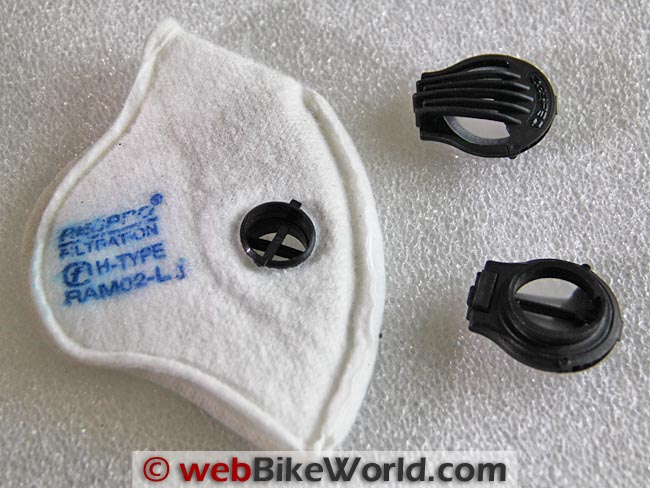
Respro Sportsta Anti-Fog Properties
Just like the Respro Foggy anti-fog mask that Respro markets, the Sportsta also has the effect of trapping exhaled water vapour and keeping it away from your face shield and/or eyeglasses.
The high-flow valves on either side of the Sportsta mask make breathing easy. I have used the mask in 35+ degree heat and high humidity and didn’t have any trouble with a “wet face” after riding. Helmets with good chin bar vents will do even better, considering the Shark S 900 doesn’t have a high flow vent in this area.
Respro Mask Filters
All three Respro masks have the same basic design, so if you own one, you can switch filters around easily. It’s a simple task of unscrewing the valves, then the filter, and vice versa. Spare filters are sold in a pack of two, and Respro recommend replacing them every four to six weeks with daily use.
The Techno filter is an extra-cost option with the Sporsta mask; the Techno filter is standard on the City and other masks. It feels a little more sturdy and less flexible than the HEPA filter in the Sportsta.
The Techno filter includes an additional charcoal layer — what Respro calls “Dynamic ACC” (Activated Charcoal Cloth) , which gives it a lower rate of air flow but the added benefit of removing odours. For motorcyclists, this means if you’re stuck in traffic behind a rubbish truck, you don’t have to make any premature or ill-advised overtaking moves — you won’t smell anything!
The Sportsta itself has (ironically) a strong plastic smell, so rinsing it once or twice before use is a good idea, although the odour will simply go away with frequent use. But the whole idea behind the standard filter and the “Powa” valve setup on the Sportsa is that it has a much higher airflow rate (i.e., allows more air in and out) and it is designed for the more aerobic type of outdoor activities.
As stated by Respro, “The Sportsta mask offers maximum ventilation without sacrificing filtration and to maximize rider performance.”
We evaluated that claim by jogging whilst wearing the Sportsta mask with the standard HEPA filter and Powa vents; it’s a little claustrophobic, but it’s something we wouldn’t even begin to try with the Techno filter.
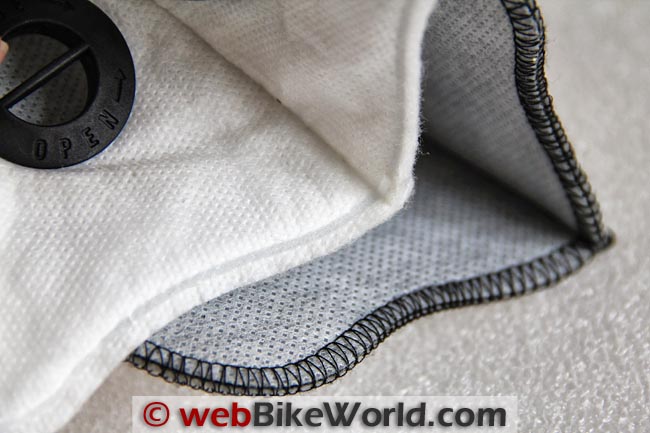


Wearing the Respro Sporsta With a Motorcycle Helmet
The comfort of the mask itself will also depend on your helmet design, as it does protrude some distance forward from your nose. Flip-ups and jet helmets, as mentioned, will have an easier time of it, as will cross-touring style helmets with their prominent front “beak” chin bar designs. Not all helmets are created equally of course; the mask doesn’t fit inside my old AGV Stealth, for instance, which has a chin bar that’s very close to the face.
But overall, the Sportsta mask works fine with full-face helmets…although it has what I like to call the “Leatt Brace” effect that comes into play.
Wearing a Leatt neck brace (review) isn’t uncomfortable; when set up properly, it’s more or less invisible. It’s whether or not you wish to put up with it. If you’re already a ATGATT kind of biker, you’ll have to find a place to put all your safety gear once you’ve reached your destination.
For me, gearing up to ride already consists of putting on earplugs (reviews), the Respro mask, a helmet, eyeglasses and gloves. By the time I’m good to go, some of my more cavalier riding buddies have already disappeared down the road!
A side note on breather fitting: Wearing a respirator means you have to fit it properly for it to work first, which means when you breathe in, you should feel the mask “sucking” onto your face. Conversely, the mask should feel like it’s pushing out when you exhale.
The stiffer construction of the Techno filter means that the mask is less conforming to the face and thus it must be adjusted constantly to achieve a good seal. Again, if you’re wearing an open-face or enduro-style helmet this will not be an issue.
OK — Does It Work?
The final question is, of course, does it really work? Well, I’ve read through numerous testimonials online, mostly from bicyclists, who swear by it, saying they can see the dirt trapped in the HEPA filter and wearing a Sporsta or other Respro mask helps them avoid feeling poorly after a week of urban commuting.
Singapore, where I live, doesn’t usually have terrible smog conditions. But barely a month after I got the Sportsta mask, the worst smog in history rolled into town from neighbouring Indonesia, courtesy of forest fires and a dry spell (see this BBC online report “Singapore hit by highest haze levels in 16 years“).
Having evaluated the Respro Sportsta mask in AQI equivalent readings of more than 300 (rated as “HAZARDOUS: Everyone should avoid any outdoor exertion; people with respiratory or heart disease, the elderly, and children should remain indoors”), I can say I was pretty darned glad to be wearing it.
Again, the HEPA filter of the Sportsta mask didn’t filter out the acrid, burning smell of the smog itself, but the Techno filter, with its activated carbon/charcoal layer, did.



Conclusion
At £32.99 ($56.00 USD here) with the standard HEPA filter, plus another $18.00 (here) if you add a two-pack of Techno filters, the Sportsta Mask isn’t particularly cheap.
Those facing a daily commute through heavy traffic should certainly consider the added protection, but — and this is a big but — something much cheaper, like a 3M N95 dust respirator ($14.00 here) may also do the same job, although necessitating more frequent replacement (and it looks like something a surgeon might wear).
The Techno filter upgrade kit, which comes with a Techno filter and valves, adds on a higher dimension of protection, as well as removing smells. But, as it is with most other bike gear, fit and comfort are the most important points when considering a Respro Sportsta mask — bring your helmet along and try before you buy, if possible.
| wBW Review: Respro Sportsta Mask | |
|---|---|
| Manufacturer: Respro (UK) | List Price: £32.99 |
| Colors: Black or Pink | Made In: Unknown |
| Sizes: Medium and Large | Review Date: July 2013 |
Owner Comments and Feedback
See details on submitting comments.


